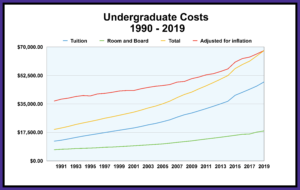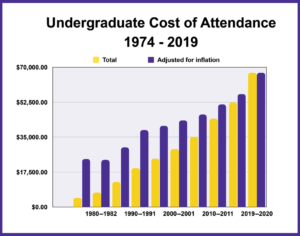The college does not plan to end annual tuition increases, President M. Lee Pelton said in an interview. Emerson follows the national trend of rising higher education costs in colleges and universities across the country
Pelton said he hopes the college will slow the rate of increase over time—this year’s increase was half a percentage point lower than in 2018–19. Pelton could not say whether Emerson will ever stop raising tuition.
“I wouldn’t wish to commit the college to a promise they cannot keep,” Pelton said.
The college increased undergraduate tuition and room and board for the 2019–20 academic year by 4 percent for returning students and 5.5 percent for new students. Pelton said the higher cost covers increases to faculty and staff salaries, financial aid, and maintenance costs that come with Little Building’s reopening in fall 2019.
Pelton said the difference in increases for new and continuing students is a one-time policy, and further tuition increases will stay the same for all students in future years. The college implemented a similar staggered increase for students who entered the college prior to 2015, when the tuition increased by 7.4 percent.
Pelton added that nine of the college’s 17 closest competitors—such as Brandeis University, Boston University, and Northeastern University—operate with higher tuition than Emerson.
“Our charge for tuition is relative to what our peers are charging,” Pelton said.
Pelton defended the increase by citing a 10 percent increase to faculty and staff salaries and benefits, which account for 41 percent of the college’s overall budget. He also said financial aid accounts for 18 percent and increased from $47 million for 2018–19 to $50 million for 2019–20. Pelton said investments and building operations make up 15 percent of the budget, and the college reduced a large fraction of the operational costs last year because Little Building was not in use. Â
Private nonprofit four-year colleges increased their total cost of attendance at an average rate of 2.3 percent per year over the last decade, according to statistics adjusted for inflation released by the College Board. Emerson increased its attendance costs, accounting for inflation, at an average of 2.8 percent per year over the same time span.

Ian Mandt, the Student Government Association executive treasurer, said he does not think the tuition increase trend is localized to Emerson in particular.
“Higher education as a whole is broken nationally, and I think that that is where the real problem is,” Mandt said. “Obviously there’s always ways that Emerson can do more and do better, but I would encourage students who are angry about the tuition increase to focus that anger at the state and at the federal government.”
Accounting for inflation, Emerson’s cost of attendance has increased by 84 percent since 1990, when tuition cost students $12,096, with additional room and board and fees bringing the total to $19,303 per year. The average cost of attendance at four-year private colleges in 1990 was $17,010, according to the College Board.
As the current SGA executive treasurer, Mandt serves as the student representative on the Budgetary Planning and Priorities Advisory Committee.
“[BPPAC] provides recommendations to the President’s Council about how the budget should be allocated,” he said.
The President’s Council includes Vice President for Diversity and Inclusion Sylvia Spears, Vice President for Enrollment Management Ruthanne Madsen, and various other college vice presidents.
Mandt said the death of Maureen Murphy—the former vice president of administration and finance—made the budgeting process particularly challenging this year. Mandt said he did not have many of his usual opportunities for input that come with his role in BPPAC, and Philip Shapiro, the current vice president for administration and finance, is only in the role as an interim.
Freshman Brady Baca is running for SGA executive treasurer on a platform of financial affordability and transparency. The freshman faces criticism for using aggressive, fear-mongering rhetoric in his campaign.
Baca said that, if elected, he would want to expand the role of the executive treasurer to advocate more on behalf of students.
“I want to work to establish a formalized process of student budgetary overview,” Baca said. “I want to expand student representation on the Board of Trustees, as well as faculty and staff representation.”
Junior SouJee Han, a student at Kasteel Well this semester, said she received the tuition update email while traveling with friends. Han said she felt frustrated that the increases do not seem to improve her experience at the Boston campus, such as the quality of the food at the Dining Center, and spoke with Vice President of Enrollment Ruthanne Madsen to talk about her financial situation.
“Emerson focuses a lot on expansion,” Han said. “What [the school] fails to understand—what Lee Pelton, and the Board of Trustees, and the higher-ups fail to understand—is they’re not taking care of their students right now.”
Baca also expressed concerns that the college’s vision does not align with what students want.
“I feel the college is [increasing tuition] because they think that they’re moving Emerson forward into the future,” he said. “It’s just my serious concern that the future they’re moving [toward] is not going to be for everyone at this school—particularly lower-income people.”

Pelton defended the college’s decision to raise tuition by dedicating a portion of the increased financial aid budget to help students from low-income backgrounds. Â
“We increased [financial aid] by almost 3 million dollars,” Pelton said. “One million dollars of that three million dollars was specifically targeted for low-income students.”
Han said she believes socioeconomic status and race are closely related, so the tuition increases will only worsen Emerson’s diversity disparity. Emerson’s fall 2018 admitted undergraduate class was 56 percent white.
“It just makes me upset because to get an education—a decent education and opportunities—you have to be rich,” Han said. “And that’s just not the way that it should be.” Â
Baca said that, although the college will use the increase to benefit staff and faculty salaries, he believes the 4 percent tuition hike is too high.
“It seems that the investments toward improving wages and benefits for faculty and staff—as well as increasing financial aid—weren’t up to the standards that I would like to see for an increase of that size,” he said.
The increase in faculty and staff salaries comes as the college plans to finalize negotiations of the last of three faculty contracts.
“We continue to make investments in our academic mission by adding great faculty, paying them well, and adding programs that prospective students want,” Pelton said.
Pelton said that students should bring their concerns about increased tuition to the financial aid office and that the office will work with students to fit their individual needs. He said financial need makes up the majority of the aid budget.
“For every dollar the college spends on financial aid, 65 to 70 percent of that dollar is for [financial] need,” he said. “The other 35 to 30 percent is for merit scholarships.”
Pelton said he does not expect the tuition increases to deter application or enrollment numbers.
“When I arrived, our applications were [at] 7,500—today they’re 15,000,” he said. “We’ve gone from accepting about 48 percent of students who apply to about 31 percent this year. So the enrollment numbers suggest that the demand for an Emerson education is even greater now than it was.”